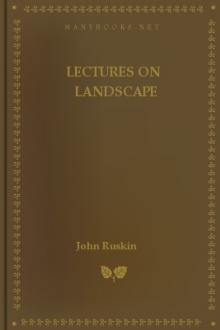The Seven Lamps of Architecture by John Ruskin (books like harry potter TXT) 📕

- Author: John Ruskin
- Performer: -
Book online «The Seven Lamps of Architecture by John Ruskin (books like harry potter TXT) 📕». Author John Ruskin
Intersectional Mouldings.
XXVIII. There was, however, in this kind of involution, much to be admired as well as reprehended, the proportions of quantities were always as beautiful as they were intricate; and, though the lines of intersection were harsh, they were exquisitely opposed to the flower-work of the interposing mouldings. But the fancy did not stop here; it rose from the bases into the arches; and there, not finding room enough for its exhibition, it withdrew the capitals from the heads even of cylindrical shafts, (we cannot but admire, while we regret, the boldness of the men who could defy the authority and custom of all the nations of the earth for a space of some three thousand years,) in order that the arch mouldings might appear to emerge from the pillar, as at its base they had been lost in it, and not to terminate on the abacus of the capital; then they ran the mouldings across and through each other, at the point of the arch; and finally, not finding their natural directions enough to furnish as many occasions of intersection as they wished, bent them hither and thither, and cut off their ends short, when they had passed the point of intersection. Fig. 2, Plate IV. is part of a flying buttress from the apse of St. Gervais at Falaise, in which the moulding whose section is rudely given above at f, (taken vertically through the point f,) is carried thrice through itself, in the cross-bar and two arches; and the flat fillet is cut off sharp at the end of the cross-bar, for the mere pleasure of the truncation. Fig. 3 is half of the head of a door in the Stadthaus of Sursee, in which the shaded part of the section of the joint g g, is that of the arch-moulding, which is three times reduplicated, and six times intersected by itself, the ends being cut off when they become unmanageable. This style is, indeed, earlier exaggerated in Switzerland and Germany, owing to the imitation in stone of the dovetailing of wood, particularly of the intersecting of beams at the angles of châlets; but it only furnishes the more plain instance of the danger of the fallacious system which, from the beginning, repressed the German, and, in the end, ruined the French Gothic. It would be too painful a task to follow further the caricatures of form, and eccentricities of treatment, which grow out of this singular abuse—the flattened arch, the shrunken pillar, the lifeless ornament, the liny moulding, the distorted and extravagant foliation, until the time came when, over these wrecks and remnants, deprived of all unity and principle, rose the foul torrent of the renaissance, and swept them all away. So fell the great dynasty of mediæval architecture. It was because it had lost its own strength, and disobeyed its own laws—because its order, and consistency, and organization, had been broken through—that it could oppose no resistance to the rush of overwhelming innovation. And this, observe, all because it had sacrificed a single truth. From that one surrender of its integrity, from that one endeavor to assume the semblance of what it was not, arose the multitudinous forms of disease and decrepitude, which rotted away the pillars of its supremacy. It was not because its time was come; it was not because it was scorned by the classical Romanist, or dreaded by the faithful Protestant. That scorn and that fear it might have survived, and lived; it would have stood forth in stern comparison with the enervated sensuality of the renaissance; it would have risen in renewed and purified honor, and with a new soul, from the ashes into which it sank, giving up its glory, as it had received it, for the honor of God—but its own truth was gone, and it sank forever. There was no wisdom nor strength left in it, to raise it from the dust; and the error of zeal, and the softness of luxury smote it down and dissolved it away. It is good for us to remember this, as we tread upon the bare ground of its foundations, and stumble over its scattered stones. Those rent skeletons of pierced wall, through which our sea-winds moan and murmur, strewing them joint by joint, and bone by bone, along the bleak promontories on which the Pharos lights came once from houses of prayer—those grey arches and quiet isles under which the sheep of our valleys feed and rest on the turf that has buried their altars—those shapeless heaps, that are not of the Earth, which lift our fields into strange and sudden banks of flowers, and stay our mountain streams with stones that are not their own, have other thoughts to ask from us than those of mourning for the rage that despoiled, or the fear that forsook them. It was not the robber, not the fanatic, not the blasphemer, who sealed the destruction that they had wrought; the war, the wrath, the terror, might have worked their worst, and the strong walls would have risen, and the slight pillars would have started again, from under the hand of the destroyer. But they could not rise out of the ruins of their own violated truth.
CHAPTER III. THE LAMP OF POWER.I. In recalling the impressions we have received from the works of man, after a lapse of time long enough to involve in obscurity all but the most vivid, it often happens that we find a strange pre-eminence and durability in many upon whose strength we had little calculated, and that points of character which had escaped the detection of the judgment, become developed under the waste of memory; as veins of harder rock, whose places could not at first have been discovered by the eye, are left salient under the action of frosts and streams. The traveller who desires to correct the errors of his judgment, necessitated by inequalities of temper, infelicities of circumstance, and accidents of association, has no other resource than to wait for the calm verdict of interposing years; and to watch for the new arrangements of eminence and shape in the images which remain latest in his memory; as in the ebbing of a mountain lake, he would watch the varying outlines of its successive shore, and trace, in the form of its departing waters, the true direction of the forces which had cleft, or the currents which had excavated, the deepest recesses of its primal bed.
In thus reverting to the memories of those works of architecture by which we have been most pleasurably impressed, it will generally happen that they fall into two broad classes: the one characterized by an exceeding preciousness and delicacy, to which we recur with a sense of affectionate admiration; and the other by a severe, and, in many cases, mysterious, majesty, which we remember with an undiminished awe, like that felt at the presence and operation of some great Spiritual Power. From about these two groups, more or less harmonised by intermediate examples, but always distinctively marked by features of beauty or of power, there will be swept away, in multitudes, the memories of buildings, perhaps, in their first address to our minds, of no inferior pretension, but owing their impressiveness to characters of less enduring nobility—to value of material, accumulation of ornament, or ingenuity of mechanical construction. Especial interest may, indeed, have been awakened by such circumstances, and the memory may have been, consequently, rendered tenacious of particular parts or effects of the structure; but it will recall even these only by an active effort, and then without emotion; while in passive moments, and with thrilling influence, the image of purer beauty, and of more spiritual power, will return in a fair and solemn company; and while the pride of many a stately palace, and the wealth of many a jewelled shrine, perish from our thoughts in a dust of gold, there will rise, through their dimness, the white image of some secluded marble chapel, by river or forest side, with the fretted flower-work shrinking under its arches, as if under vaults of late-fallen snow; or the vast weariness of some shadowy wall whose separate stones are like mountain foundations, and yet numberless.
II. Now, the difference between these two orders of build-ing is not merely that which there is in nature between things beautiful and





Comments (0)